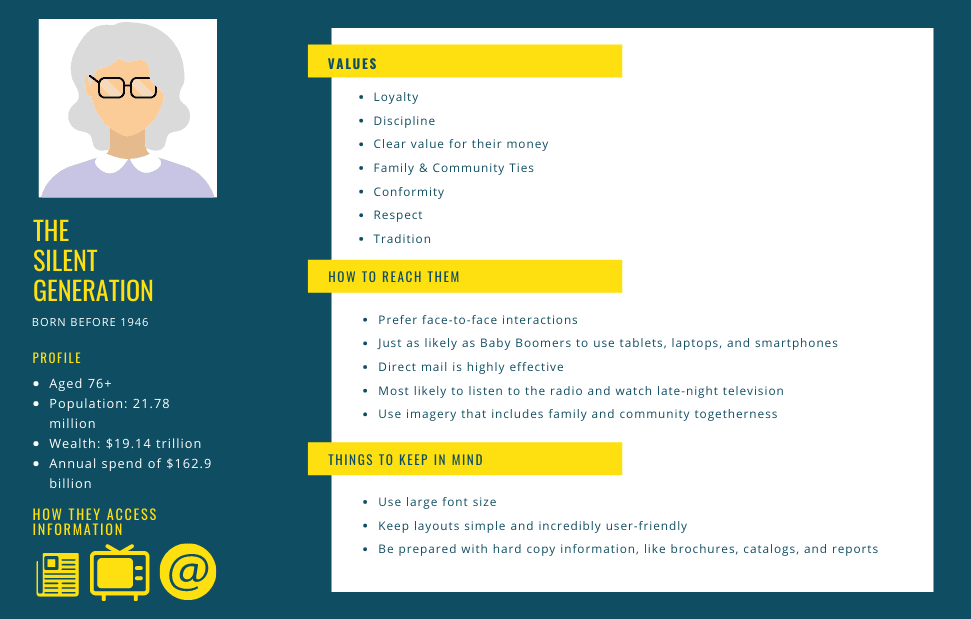Silent Generation: Marketing Strategies & Digital Trends

Despite being one of the essential components of an effective marketing strategy, age groupings are a rich and abundant data resource. It can provide a massive range of constantly changing insights, including hobbies, buying habits, lifestyle trends, the customer journey, favorite brands, and even the most notable social media networks they use regularly.
For some marketing firms, though, generational marketing proves to be a pitfall more so than an asset. This stems from the tendency to think of our customers as one-dimensional figures, fitting neatly into “data buckets” that we use to fuel our marketing efforts.
What is Generational Marketing?
Researchers define generational marketing as “the practice of appealing to the unique needs of individuals within more than one specific generational group, with a generation being a group of individuals born and living at the same time.”
The concept is based on the idea that our needs as consumers change as we transition through life stages, experiencing shared commonalities– like graduating high school, renting our first apartment, having children, becoming a grandparent, etc.
For example, the idea of shopping on social media networks or online-only stores didn’t exist a few years ago. But, as each group becomes increasingly engaged in digital, our marketing tactics must change with the times and with consumer preferences.
At this point, there are five vital generational profiles marketers are focusing on as a target audience:
- The Silent Generation
- The Baby Boomer Generation
- Generation X
- Millennials (Generation Y)
- Generation Z
The Silent Generation

Data Rundown
- Born before 1946
- Aged 76+
- Population: 21.78 million
- Wealth: $19.14 trillion
- Average Net Worth: $292,210
- Annual spend of $162.9
The Silent Generation
The Silents are a people born into turmoil.
The oldest (aged 88-97) experienced the Great Depression firsthand. As the agonizing decade from 1929 to 1939 raged on, they learned their buying behavior from their parents, who stressed the necessity of “tightening their belts” just to survive another day without wages, food, or hope. Many lost friends, family members, homes, farms, and land as the world’s most prolonged and most severe economic downturn waged war against the way of life ushered in by the Roaring 20s.
As the new decade arrived, so did a new threat of destruction. World War II saw advertising awash with messages about rationing, purchasing war bonds as a means of investing, and the importance of maintaining your own home/vehicle without depending on vital raw materials like rubber.
By the time this age group bore the younger generation of Baby Boomers, a product of Americans finally starting long-delayed families because the men were at war, many felt that peace and prosperity awaited the years to come. As the Silent Generation continued to sacrifice for the sake of future security, their children entered the relative luxury of post-war economic expansion, commonly referred to as the Golden Age of Capitalism.
Silent Generation Marketing
First and foremost, you must do away with the assumption that technology has no place in marketing to the Silent Generation.
While they did not grow up as deeply entrenched in technology as the newer age groups, they have spent the last 30+ years living, working, and experiencing an increasingly digital society. Along the way, they have picked up some level of skill in navigating online content.
Blending a traditional approach with a highly targeted digital rollout will ensure your brand can develop campaigns that meet the expectations and needs of your customers.
How to Reach the Silent Generation
Because they lived through America’s worst economic downturn– The Great Depression– the Silent Generation is a cautious consumer. They know the value of saving, conservatism, and finding creative ways to make their dollar stretch.
Marketers can appeal to those sensibilities by having a laser focus on the cost-value of your goods and services. When marketing to the silent generation, you can worry less about online reviews and more about how you plan to prove to them that your offer is worth parting with their hard-earned cash.
They also tend towards conformity, preferring to “go with the flow” rather than making waves. That translates to an expectation for their preferred brands to do the same. They aren’t interested in significant innovations or complicated processes. Instead, they’re happy with “par for the course.”
The Silent Generation is also the most likely to engage with print rather than digital.
Prioritize Face-to-Face Experiences
While a growing number of those born into this generation are leaping to become tech-savvy, the vast majority are still more comfortable in face-to-face settings. Unlike those of us born into a world dominated by email, text messaging, and social media platforms, the Silent Generation grew up having conversations the old-fashioned way.
Skip the Age-Related Images
While most generations respond well to seeing people their age in advertisements, this age group cannot say the same. Unsurprisingly, the Silent Generation does not want to be represented as fragile, incapable, or addled. Instead, they want to be reminded that they still have a lot of life left to live and that your product or service can help enhance their golden years.
Because their priorities rest in building a legacy through their community and family, choose visuals that emphasize those ideas in your silent generation marketing materials.
Consider Radio and Television Advertisements
Sixty-eight percent of those 65+ get their news from television, compared to the 48% that prefer a smartphone, computer, or tablet.
An additional 21% say that the radio is their primary source of information.
That puts them in the lead for both media types over the other four generations who are currently active consumers, so a marketing plan that involves either option would have a more significant reach than one only investing in online content.
But Don’t Ignore Digital
According to Pew Research, the Silent Generation hit a considerable stride in owning technology in the last decade.
- Smartphone ownership increased 30% to 40% from 2018 to 2019.
- Tablet ownership increased from 25% to 33% from 2018 to 2019.
- Social media usage increased from 23% to 28% from 2018 to 2019.
Along with those increases comes an uptick in social media usage. Forty-five percent of the 65+ age group say they participate in social media networking.
While the percentages aren’t nearly as large as in Millenials and Gen Z, the growth is profound and worth some of your marketing resources. Be sure to employ plenty of A/B testing to determine what sticks or needs retooling.
If you’re going to take the social media approach, skip everything but Facebook (50%) and YouTube (49%).
Snapchat, Instagram, TikTok, and Twitter all carry less than 15% usage amongst the Silent Generation, so reinvest that part of your budget back into more traditional print forms or into bolstering your Facebook and YouTube presence.